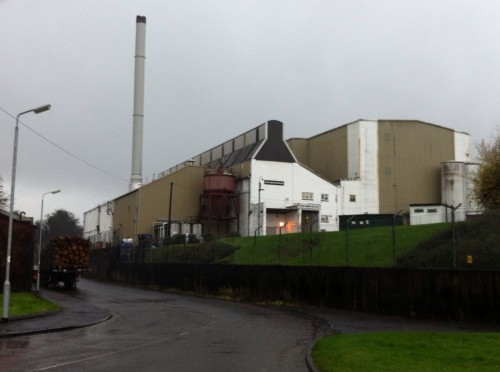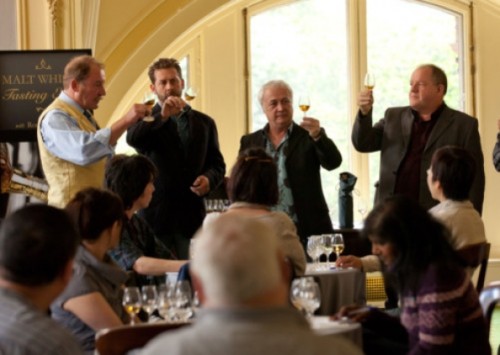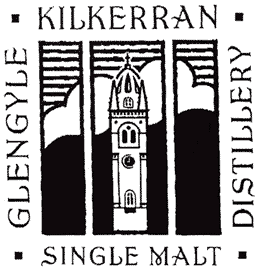(Last week Jennifer Kabat looked at the history of scotch whisky, which owes itself to accidents like the Revolutionary War, labor relations in the US, as well as a louse and a queen.)
WITH SCOTCH I was on this quest of my own looking, yes, for how it’s really made, or what it really is. I had some idea that there was a book in it or an idea of making malts in the Catskills, a water-into-wine fantasy somewhere between Ken Loach’s The Angel’s Share and its Cinderella story and Brooklyn – with the borough’s perceived penchant for home-brewing and distilling (not to mention pickling and charcuterie-making). The climate seemed right in the Catskills for whisky. (Note the missing “e.” The whiskeys with an “e” are Irish and bourbon and rye). Like Scotland, the land here is not great; the soil could grow barley, I was sure. The costs seemed to be in the ageing, so I set out to visit distilleries to see how they work. Most though have a kind of basic arithmetic to them, or so it seems from the distillery tours.
There’s an equation to them: jokes about happy cows who eat the spent grain (out the window will be grazing highland cattle). There are stories about the water the distillery uses and how prized the source as well as the illegal still which once stood on the site where you stand now (this information is delivered in the tour guide’s poetically trilled Highland accent). There will be legendary feuds plus bootlegging, and a resident ghost. Just as you see in the movie at Deanston – one of the distilleries where The Angel’s Share was shot – the tartan-clad guide will tell you that replacing the still requires forging one that mirrors the original to a fault, copying even the patches and imperfections, so the spirit’s taste will be the same. There will be whitewash on all the buildings (plus perhaps a bit over the stories as well). The guide will show you the pagoda roof under which they once smoked the barley with peat, though this is now, except for at Springbank, done only at a few central maltings across Scotland. The whole experience will end in the gift shop, where you can, of course, purchase the malt you’ve just seen made.
Springbank’s Frank McHardy set out to try and see all the Speyside distilleries (there are nearly 50, not all open to the public). “You need,” he says, “to be quite a nut if you want to visit every one of them. I tried it out once, said I’d do the entire Speyside Whisky Trail. After four distilleries, I gave up.” They’re kind of all the same. Then, Harry Rifkin, the chemist, suggests I meet John Peterson at Loch Lomond on the outskirts of Glasgow. The distillery’s not pretty, Rifkin warned, but I’d learn something about scotch.
Loch Lomond doesn’t welcome visitors. There’s no shop where at the end of the tour you get a dram for the price of admission. The place looks like a factory or a submarine, and John Peterson, another chemist, runs it. In a sense he’s like Frank, in that way polar opposites can be similar. Both rebel against the way most distilleries work, one cleaving to the past in the face of progress, the other pushing the boundaries.
John is elfin with delicate features and the ghost of a smile imprinted on his cheeks. He came to scotch from beer, had studied chemistry and then after school was “bumming around Suffolk,” as he puts it, and ended up working in the maltings for a brewery. Now he has the recipe for Stella and makes the strong lager at home. Here at Loch Lomond he makes a malt but isn’t allowed to call it that, not legally. He guides me through his lab where distillate drips from a Chemex coffee pot and something called a beer analyzer with flashing buttons and a ticker tape out the top measures the alcohol yield in the wash. He tests it daily and his distillate five times a day with a gas spectrometer. Springbank, on the other hand, does their testing once a year, sending it to Rifkin for analysis.
Downstairs in a large hall the still men watch computer monitors. Towering over everything are giant steel canisters – a continuous still. Most single malt makers would find it an affront to their very being, but John is all about exploring and experimenting, and his experiments include a bit of reverse colonialism. The idea for his column still came from India.
Kasauli Distillery in the Himalayas was built in 1820s by an Englishman. It strikes me as ironic that one Indian malt distillery has been going longer than most in Scotland, even using some of the original pot stills brought from Scotland. Kasauli also now makes a malt in a column still. Harry Rifkin saw it and told John, who decided to give it a go. I love that someone took scotch to India and now back to Scotland to influence someone there, only Peterson can’t call what he makes “scotch” or “malt.” Four years ago the UK’s law around what qualifies as “scotch malt whisky” was changed because of John. Now a malt has to be made in pot stills. Which seems, to me, ironic given that a malt was first released as a kind of marketing experiment, and now single malts are so popular that just what constitutes one has to be codified, while the hatred of a column still seems a last holdout of a north/south divide.
Loch Lomond’s malt (or whatever you’re supposed to call it) is good though. It’s mainly used in blends sold as supermarkets’ own-brands that continually get great reviews, outflanking their named and pricier peers. More than that – making a malt in a continuous still cut his energy use radically. Instead of distilling twice, heating one still then cooling it and heating another, he makes his malt faster in the column, with more contact with copper, what is called on a distillery tour, “the conversation with copper.” The amount of contact the spirit has with the soft metal moderates the sulfur, taming the flavor of the whisky.
On the phone later Rifkin says, “Malts have a mythology and mystery tied to pot stills, but the industry needs to step back to before 1830. The continuous still can make pure malt relatively quickly. Then the SWA, (that is, the Scotch Whisky Association, which lobbied the British government to change the law) they’ve defined malt as having to be 100% malt made only in pot stills. I don’t think that’s correct; that’s about an industrial process. So, John is making a high quality malt, and forced to call it ‘grain whisky,’ which it isn’t. It’s malted in the same way, using mash and worts that go into pot stills and he does the analysis of both, and they’re the same.”
In his lab Peterson picks up a sheaf of papers analyzing that day’s malt production and says he worries for the future of whisky. “The single malt is destroying it. They’re trying to codify something that was and is always changing. When we become a tourist industry –” he shakes his head and even when angry his voice is gentle, this wizardly man with a small pinch at his cheeks that could be a smile. “What really upset me about the Scotch Whisky Association is they wouldn’t even taste the malt from a column still. They sent a group to examine my production but none of them would taste it. They just looked at the still. Really the malts industry is all kilts and brand ambassadors.”
Today Loch Lomond is for sale; rumors have it going to a private equity firm which also owns Quorn, yes, the fake-meat makers. One of the last distilleries with family ownership, it’s currently owned by Sandy Bulloch, whose family have been involved in the whisky industry since 1842. He will walk away. Perhaps the hassles with the scotch whisky establishment proved too much.
~
In the movie Charles Maclean leads a scene of a fancy whisky tasting in Edinburgh (itself a fancier city than Glasgow where the kids are from). They’re at the tasting with their probation officer, all of them out of place, of course, this being a fairytale. Robbie is pushed to stand up and do a blind tasting with Maclean, guessing the distillery and exposing that the teen has a good nose for scotch. In real life Maclean, who has a waxed mustache that would fit in in Brooklyn or Portland and who trills his Rs musically, is a Master of the Quaitch, a title awarded for service to scotch.
A star of the malt whisky world, he hosts guided tastings and after-dinner talks and is author of many books on scotch, guidebooks and compendia. Watching, I keep thinking his character Rory McAllister is the movie’s bad guy as he describes the scotch: “A Lagavulin with a fine color and a a beautiful, rich and a–” dramatic pause “–somewhat maritime nose.” The long pause sounds to me like he’s searching for words, a bit like pulling a rabbit from the air. Then, when he says that the night before he’d tried a sample that he describes as “a ten out of ten,” the best he’d ever had and that it’s coming up for auction in a week, I’m sure it’s a great big confidence trick. As I watch, I have to remind myself that he consulted on the script; he’s basically playing himself; he wouldn’t be a crook. That would hurt his standing in his real world too much.
In the movie the plot revolves around a rare cask being auctioned off, the whisky he called “a ten out of ten.” The price soars well north of a million pounds. The kids siphon off a bit to sell to a shady dealer and pay for their escape from poverty. In the scene at the auction the McAllister/Maclean character/real person tastes some of the scotch and describes it: “It’s color says it was aged in American oak…” He banters with the audience, joking about how he wishes he could share it with them and stands before them declaring it “sublime” and “superb.” The fictional Maclean with his handlebar mustache, the sort that would have marked him out as a villain tying a girl to the railway tracks in silent movies, has to be fooling the auction-goers. He has to be in on the scam. He’s not, but maybe this is my own naturally suspicious nature or the combined influence of Peterson and McHardy, who are both wary of the whisky establishment that Maclean represents. Although I am also sure it’s Maclean’s doing that little-known Springbank is even in the film. That is just such a detail he’d think to include, raising the profile of a small distillery here.
~
Back in Campbeltown it strikes me as ironic that the city is equidistant between Islay and Ireland, the island where scotch is now booming, employing nearly all 3000-some residents and the place where whisky supposedly began. I’ve toured the Glen Scotia distillery, and seen no ghost, though I have seen all of its skeletal staff. The distillery is overseen by Peterson with three local men operating it, making it the country’s smallest distillery, and the malts (which he can call “malts”) are used exclusively in his blends. The other two distilleries here are run by Frank McHardy. We walk through the town in more whipping rain and wind, and it feels like I am with the ghosts of Whisky City. He shows me the walls where distilleries once stood, where now they guard gardens and have been incorporated into houses.
He says something about “day-glo,” his name for Diageo, the biggest global scotch whisky producer, and points out the company’s last remnants in Campbeltown, empty crumbling walls where only fifteen years before whisky was aged on the site of a distillery they’d bought decades earlier. Uphill on a road of mansions are the homes of two feuding brothers built one just a street above the other, both virtually the same, both with a view to Campbeltown Loch, both competing for size and height, one brother pleased at his luck in being higher than the other. One place is now a care home, the other country house hotel, a particularly British institution in the vein of Fawlty Towers.
Thanks to a family feud, the Mitchell brothers who founded Springbank had three different distilleries, one for each brother. Their sister Mary was partner in a fourth. In 1925, the same year the large whisky blenders John Walker and Sons and Buchanan’s joined the DCL (Diageo’s corporate forebear) the Mitchell’s third distillery Glengyle closed. Since, it’s been a laundry, small-bore rifle range, and the Kintyre Farmer’s Co-op. The building itself was made of ballast put on ships, the stones thrown over as the boats picked up cargo, casks of whisky in Campbeltown. The walls of Glengyle were built of the cheap rock after the brothers fought about sheep.
McHardy points out the malt kiln that was more recently used for packaging feed and recounts the same walk he did a decade ago with Springbank’s current owner, Hedley Wright, the great, great, great grandson of Archibald Mitchell – whose illicit still became Springbank. McHardy and Mr. Wright, as Frank carefully calls him, never lapsing into the familiar, passed Glengyle, and it was up for sale.
“Just as I’m saying to you as we walk here, he said to me,” Frank explains, “‘my great, great uncle once owned it and I’m going to open it again.’” Wright didn’t want it because they needed more production space, but because he wanted it back. He wanted to bring it back.
I ask about Mr. Wright and how closely involved he is with the company, which includes Cadenheads series of whisky specialist stores with branches in Edinburgh, Campbeltown, London and Denmark. He lives in Edinburgh.
“Mr. Wright is the chairman of the company.” Full stop. “So, he’s involved with everything.”
“But, you don’t see him on a day-to-day basis, and he doesn’t call you on a day to day basis?”
“Ach no.”
“Can I speak to him to ask him a couple questions?”
Chain jingles in his pocket, as if the question makes him anxious or impatient. “Nope. No, our Mr. Wright is a very private person.” More jingling. “You don’t need to ask questions of Mr. Wright. Sorry.”
I say okay; he gives his nervous laugh, a little chuckle of punctuation and leans forward, and the way he both chuckles and leans says that door of conversation is closed.
McHardy shows me the view through a window in the wall, the hole has bars over it, like a prison. From here you can see past the wild buddleia growing in the cracks to the church tower at the center of town. A drawing of this view is on bottles of Kilkerran, the malt made now at Glengyle and taken from Campbeltown’s ancient Gaelic name (the site of Saint Kieran’s cell). As I stare through the bars at the church spire, it strikes me that maybe he, Frank McHardy is Hedley Wright. There are no pictures of Wright online. I can’t speak to him. The only references to him I find are on donor lists for a performing art center in Perth and supporters of the Edinburgh Festival. Only that would be the outcome in a Ken Loach movie, that the uneducated former laborer and the rich scion of a scotch family out to protect his workers and traditional malt whisky could be one and the same.






